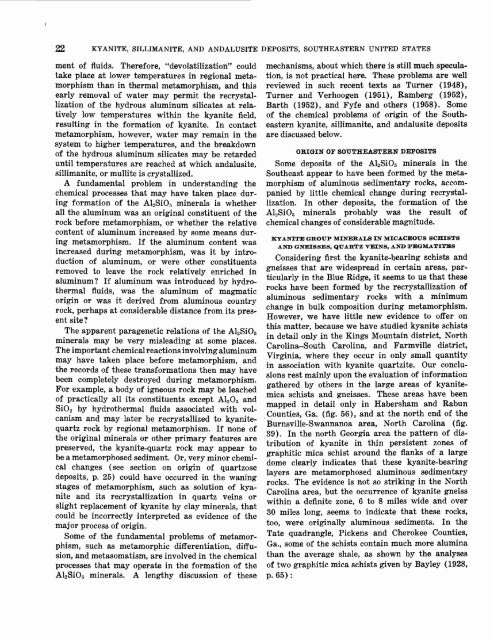Kyanite, Sillimanite, and Andalusite Deposits of the Southeastern ...
Kyanite, Sillimanite, and Andalusite Deposits of the Southeastern ...
Kyanite, Sillimanite, and Andalusite Deposits of the Southeastern ...
Create successful ePaper yourself
Turn your PDF publications into a flip-book with our unique Google optimized e-Paper software.
22 KYANITE, SILLIMANITE, AND ANDALUSITE DEPOSITS, SOUTHEASTERN UNITED STATES<br />
ment <strong>of</strong> fluids. Therefore, "devolatilization" could<br />
take place at lower temperatures in regional metamorphism<br />
than in <strong>the</strong>rmal metamorphism, <strong>and</strong> this<br />
early removal <strong>of</strong> water may permit <strong>the</strong> recrystallization<br />
<strong>of</strong> <strong>the</strong> hydrous aluminum silicates at relatively<br />
low temperatures within <strong>the</strong> kyanite field,<br />
resulting in <strong>the</strong> formation <strong>of</strong> kyanite. In contact<br />
metamorphism, however, water may remain in <strong>the</strong><br />
system to higher temperatures, <strong>and</strong> <strong>the</strong> breakdown<br />
<strong>of</strong> <strong>the</strong> hydrous aluminum silicates may be retarded<br />
until temperatures are reached at which <strong>and</strong>alusite,<br />
sillimanite, or mullite is crystallized.<br />
A fundamental problem in underst<strong>and</strong>ing <strong>the</strong><br />
chemical processes that may have taken place during<br />
formation <strong>of</strong> <strong>the</strong> Al2Si0 5 minerals is whe<strong>the</strong>r<br />
all <strong>the</strong> aluminum was an original constituent <strong>of</strong> <strong>the</strong><br />
rock before metamorphism, or whe<strong>the</strong>r <strong>the</strong> relative<br />
content <strong>of</strong> aluminum increased by some means during<br />
metamorphism. If <strong>the</strong> aluminum content was<br />
increased during metamorphism, was it by introduction<br />
<strong>of</strong> aluminum, or were o<strong>the</strong>r constituents<br />
removed to leave <strong>the</strong> rock relatively enriched in<br />
aluminum? If aluminum was introduced by hydro<strong>the</strong>rmal<br />
fluids, was <strong>the</strong> aluminum <strong>of</strong> magmatic<br />
origin or was it derived from aluminous country<br />
rock, perhaps at considerable distance from its present<br />
site ?<br />
The apparent paragenetic relations <strong>of</strong> <strong>the</strong> Al2SiO5<br />
minerals may be very misleading at some places.<br />
The important chemical reactions involving aluminum<br />
may have taken place before metamorphism, <strong>and</strong><br />
<strong>the</strong> records <strong>of</strong> <strong>the</strong>se transformations <strong>the</strong>n may have<br />
been completely destroyed during metamorphism.<br />
For example, a body <strong>of</strong> igneous rock may be leached<br />
<strong>of</strong> practically all its constituents except A1203 <strong>and</strong><br />
Si02 by hydro<strong>the</strong>rmal fluids associated with volcanism<br />
<strong>and</strong> may later be recrystallized to kyanitequartz<br />
rock by regional metamorphism. If none <strong>of</strong><br />
<strong>the</strong> original minerals or o<strong>the</strong>r primary features are<br />
preserved, <strong>the</strong> kyanite-quartz rock may appear to<br />
be a metamorphosed sediment. Or, very minor chemical<br />
changes (see section on origin <strong>of</strong> quartzose<br />
deposits, p. 25) could have occurred in <strong>the</strong> waning<br />
stages <strong>of</strong> metamorphism, such as solution <strong>of</strong> kyanite<br />
<strong>and</strong> its recrystallization in quartz veins or<br />
slight replacement <strong>of</strong> kyanite by clay minerals, that<br />
could be incorrectly interpreted as evidence <strong>of</strong> <strong>the</strong><br />
major process <strong>of</strong> origin.<br />
Some <strong>of</strong> <strong>the</strong> fundamental problems <strong>of</strong> metamorphism,<br />
such as metamorphic differentiation, diffusion,<br />
<strong>and</strong> metasomatism, are involved in <strong>the</strong> chemical<br />
processes that may operate in <strong>the</strong> formation <strong>of</strong> <strong>the</strong><br />
Al2Si0 5 minerals. A lengthy discussion <strong>of</strong> <strong>the</strong>se<br />
mechanisms, about which <strong>the</strong>re is still much speculation,<br />
is not practical here. These problems are well<br />
reviewed in such recent texts as Turner (1948),<br />
Turner <strong>and</strong> Verhoogen (1951), Ramberg (1952),<br />
Earth (1952), <strong>and</strong> Fyfe <strong>and</strong> o<strong>the</strong>rs (1958). Some<br />
<strong>of</strong> <strong>the</strong> chemical problems <strong>of</strong> origin <strong>of</strong> <strong>the</strong> Sou<strong>the</strong>astern<br />
kyanite, sillimanite, <strong>and</strong> <strong>and</strong>alusite deposits<br />
are discussed below.<br />
ORIGIN OF SOUTHEASTERN DEPOSITS<br />
Some deposits <strong>of</strong> <strong>the</strong> Al2Si05 minerals in <strong>the</strong><br />
Sou<strong>the</strong>ast appear to have been formed by <strong>the</strong> metamorphism<br />
<strong>of</strong> aluminous sedimentary rocks, accompanied<br />
by little chemical change during recrystallization.<br />
In o<strong>the</strong>r deposits, <strong>the</strong> formation <strong>of</strong> <strong>the</strong><br />
Al2Si0 5 minerals probably was <strong>the</strong> result <strong>of</strong><br />
chemical changes <strong>of</strong> considerable magnitude.<br />
KYANITE GROUP MINERALS IN MICACEOUS SCHISTS<br />
AND GNEISSES, QUARTZ VEINS, AND (PEGMATITES<br />
Considering first <strong>the</strong> kyanite-bearing schists <strong>and</strong><br />
gneisses that are widespread in certain areas, particularly<br />
in <strong>the</strong> Blue Ridge, it seems to us that <strong>the</strong>se<br />
rocks have been formed by <strong>the</strong> recrystallization <strong>of</strong><br />
aluminous sedimentary rocks with a minimum<br />
change in bulk composition during metamorphism.<br />
However, we have little new evidence to <strong>of</strong>fer on<br />
this matter, because we have studied kyanite schists<br />
in detail only in <strong>the</strong> Kings Mountain district, North<br />
Carolina-South Carolina, <strong>and</strong> Farmville district,<br />
Virginia, where <strong>the</strong>y occur in only small quantity<br />
in association with kyanite quartzite. Our conclusions<br />
rest mainly upon <strong>the</strong> evaluation <strong>of</strong> information<br />
ga<strong>the</strong>red by o<strong>the</strong>rs in <strong>the</strong> large areas <strong>of</strong> kyanitemica<br />
schists <strong>and</strong> gneisses. These areas have been<br />
mapped in detail only in Habersham <strong>and</strong> Rabun<br />
Counties, Ga. (fig. 56), <strong>and</strong> at <strong>the</strong> north end <strong>of</strong> <strong>the</strong><br />
Burnsville-Swannanoa area, North Carolina (fig.<br />
39). In <strong>the</strong> north Georgia area <strong>the</strong> pattern <strong>of</strong> distribution<br />
<strong>of</strong> kyanite in thin persistent zones <strong>of</strong><br />
graphitic mica schist around <strong>the</strong> flanks <strong>of</strong> a large<br />
dome clearly indicates that <strong>the</strong>se kyanite-bearing<br />
layers are metamorphosed aluminous sedimentary<br />
rocks. The evidence is not so striking in <strong>the</strong> North<br />
Carolina area, but <strong>the</strong> occurrence <strong>of</strong> kyanite gneiss<br />
within a definite zone, 6 to 8 miles wide <strong>and</strong> over<br />
30 miles long, seems to indicate that <strong>the</strong>se rocks,<br />
too, were originally aluminous sediments. In <strong>the</strong><br />
Tate quadrangle, Pickens <strong>and</strong> Cherokee Counties,<br />
Ga., some <strong>of</strong> <strong>the</strong> schists contain much more alumina<br />
than <strong>the</strong> average shale, as shown by <strong>the</strong> analyses<br />
<strong>of</strong> two graphitic mica schists given by Bayley (1928,<br />
p. 65):
















